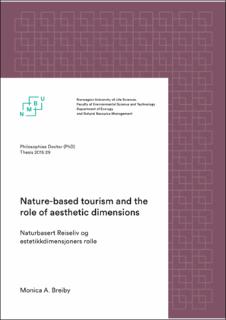| dc.description.abstract | The overall goal of the thesis is twofold. First, it aims to increase knowledge of aesthetics in nature-based tourism and to develop certain aesthetic dimensions in such a context. Second, it aims to increase knowledge of how these aesthetic dimensions influence the variables satisfaction, positive emotions, and customer loyalty. To achieve this, aesthetics in general and aesthetic dimensions in particular in nature-based tourism are explored in four papers. The methods used for data collection are qualitative interviews and a survey.
The dissertation opens up the research area with regard to nature-based tourism and the influence of aesthetic dimensions. This is one of the first systematic studies, which contributes to developing research-based knowledge of the role aesthetic dimensions play in nature-based tourists’ behaviour. Specifically, the dissertation offers three main contributions to nature-based tourism research. First, the thesis presents the concept of aesthetics from different theoretical perspectives, and empirical data from key informants’ and tourists’ understandings of central aesthetic dimensions. One of the main findings is that aesthetic qualities of nature-based destinations go beyond the visual aspects and engage all the senses. Tourists are actively sensing the overall environment, including the man-made and natural environment. Furthermore, both key informants and tourists mentioned the four aesthetic dimensions “harmony”, “variation/contrast”, “scenery/viewing”, and “genuineness”. In addition, key informants emphasized “art/architecture” and tourists emphasized “cleanliness”. The findings reveal that the dimensions “harmony” and “genuineness” are especially important for the man-made environment in nature, while the dimensions “variation/contrast” and “scenery/viewing” are important for the natural environment.
The findings confirm universal patterns of aesthetics from theoretical perspectives on how “scenery” contributes to understanding the environment, and how “variation” relates to the degree of complexity (e.g., boring or chaotic). The findings also confirm previous empirical studies in tourism that emphasize “harmony”, “scenery”, and “cleanliness”. “Genuineness” is an interesting finding with regard to the man-made environment in nature.
Second, the thesis contributes to furthering our understanding of the effects of aesthetic dimensions on tourists’ satisfaction with and loyalty to nature-based experiences. The findings demonstrate that tourists’ evaluations of the dimensions “scenery/viewing”, “harmony”, and “genuineness” affect their satisfaction with the scenic road positively, and that satisfaction has a direct influence on both the intention to recommend, the intention to revisit the scenic road and to visit similar roads. However, only the aesthetic dimensions “genuineness” and “cleanliness” have a direct effect on the intention to revisit the scenic road, and indicate at more complex explanatory pattern for the intention to recommend.
Finally, the thesis also contributes to expanding our understanding of the relationship between aesthetic dimensions, positive emotions, and loyalty. The findings reveal that tourists’ evaluations of the aesthetic dimensions “scenery/viewing”, “cleanliness”, and “genuineness” have significant effects on positive emotions towards the scenic road. Positive emotions have direct effects on both the intention to recommend, the intention to revisit the scenic road and to visit similar roads. Moreover, the aesthetic dimension “scenery/viewing” has a direct effect on the intention to recommend, and “cleanliness” has a direct effect on the intention to visit similar roads.
The main contribution of the thesis is thus not to the depth of the century-long aesthetic discussion and research in general, nor is it to aesthetic notions regarding landscape preferences, where a substantial body of literature exists. Rather, it is first of all about the role different aesthetic dimensions play in tourists’ satisfaction, positive emotions, and loyalty intentions with regard to the overall environment at a nature-based destination.
The findings have practical implications for nature-based destination management, and marketing and development processes. One example is the importance for managers to develop attractive value propositions (in networks with other providers at the destination) by emphasizing the six aesthetic qualities that go beyond the visual aspect and engage all the senses, and thus adding customer value. This can maximize the tourists’ opportunities to enjoy pleasurable experiences within the overall environment at a nature-based destination, e.g., a scenic road. Furthermore, new market knowledge about aesthetic qualities must continuously be structured, and interpreted into shared understandings among tourist providers and nature-based tourist organizations. This is especially important in development and innovation processes, thus leading to a competitive advantage for nature-based destinations. The thesis also opens up some of the areas for future research on the role of aesthetics in man-made environments (in addition to the natural environment) in nature-based tourism. When most of the other variables are similar, aesthetic dimensions or qualities may make a difference to a nature-based tourist product’s performance, and thus provide that competitive edge. | nb_NO |
